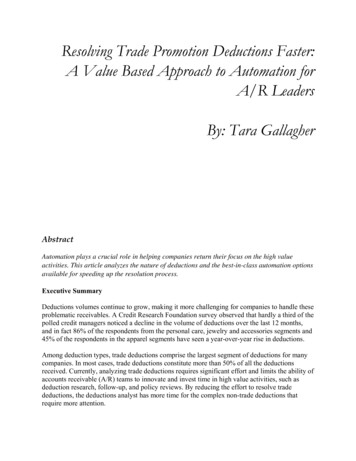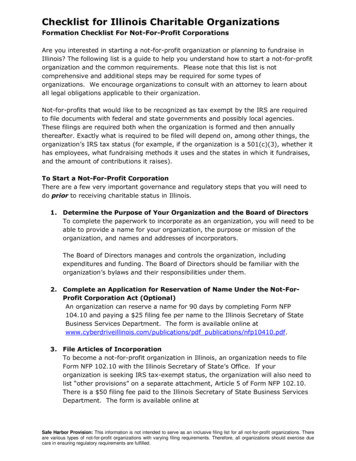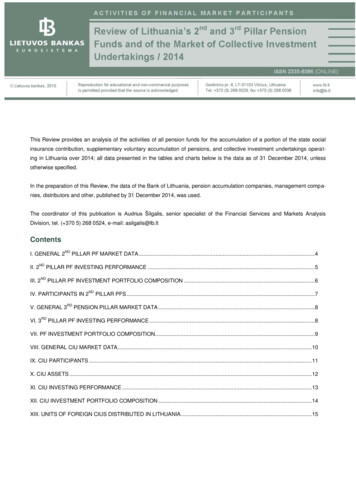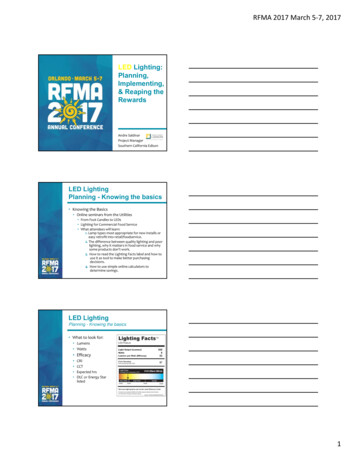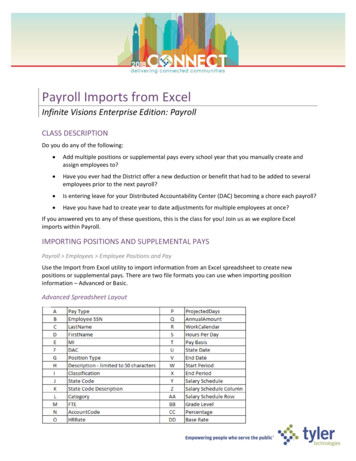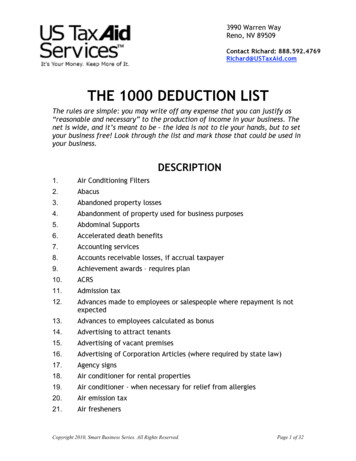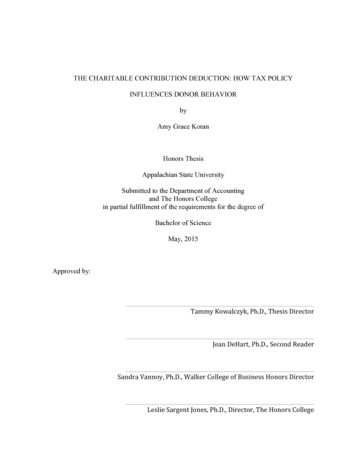
Transcription
THE CHARITABLE CONTRIBUTION DEDUCTION: HOW TAX POLICYINFLUENCES DONOR BEHAVIORbyAmy Grace KoranHonors ThesisAppalachian State UniversitySubmitted to the Department of Accountingand The Honors Collegein partial fulfillment of the requirements for the degree ofBachelor of ScienceMay, 2015Approved rector,TheHonorsCollege
Koran 1TABLE OF CONTENTSACKNOWLEDGMENTS . 3ABSTRACT . 4LIST OF CHARTS AND TABLES . 5INTRODUCTION. 6Statement of the Problem . 7Purpose of the Research . 7Significance of the Study . 7Research Questions . 8HISTORICAL REVIEW . 8Origin of the Deduction . 8Historical Review: 1917-1962. 9Historical Review: 1969-1997. 11The Charitable Contribution Deduction Today. 13REVIEW OF LITERATURE . 14Introduction to Past Studies . 14Proposal 1: Retain Current Deduction, Create New Floor . 15Proposal 2: Allow All Taxpayers to Take the Deduction . 16Proposal 3: Replace the Deduction with a Credit . 18THEORIES AND RATIONALES. 19Rationale Behind the Deduction . 19Identification of Tax Benefits with Similar Rationale . 20Motivating Factors for Taxpayers . 22The Progressive Tax System . 23METHODOLOGY . 26Objectives. 26Participants . 26Instrument . 27Procedure, Time Frame, and Design. 28Demographic . 28Assumptions. 29Scope and Limitations . 29RESULTS . 29Descriptive Statistics . 29
Koran 2Analyses of Understanding/Awareness . 33Analyses of Motivating Factors . 35Analyses of the Effect of Change to the Deduction . 38DISCUSSION AND CONCLUSION . 42Discussion. 42Conclusion . 45Implications for Future Research. 46Implications for Practice . 47REFERENCES . 48APPENDICES . 51Appendix A: Questionnaire . 51
Koran 3ACKNOWLEDGMENTSFirst and foremost, I would like to thank my thesis committee. Without the assistancefrom my thesis director, Dr. Tammy Kowalczyk, this endeavor would not have beenpossible. I would also like to express appreciation for my second reader, Dr. Jean DeHart. Iknow without doubt that it is the passion of my professors that I have seen over the course ofmy educational journey here at Appalachian State University that has inspired me tocomplete this project. I also feel it is worthwhile to mention how my experiencesvolunteering with non-profit organizations at home and abroad have fueled my interest in thestudy of incentivizing charitable giving. The non-profit sector is close to my heart and I hopeto one day serve with my strengths and experiences in the greatest capacity in order to helpthose in need. Lastly, I would like to acknowledge my parents who have endlessly supportedme and taught me from the earliest age that it is better to give than to receive.
Koran 4ABSTRACTThe primary objective of this study was to determine how tax policy impacts donorbehavior with respect to the charitable contribution tax deduction. In addition, the studyexamined the effect on giving to non-profit organizations through various proposals tochange the benefit of the charitable contribution tax deduction. The best proposal wasdetermined to be a deduction both advantageous to the taxpayers as an incentive to givefinancially to qualifying organizations and advantageous as a benefit offered by thegovernment as a result of subsidization through tax policy. Through the use of a survey, Ianalyzed the motivating factors for individuals to give and the effect on giving expected bytaxpayers through the proposed changes to the charitable contribution deduction. The studyindicated that there was an overall lack of awareness of tax policy and also demonstrated thatthe perceptions about why one personally gives differs from what one perceives are thereasons that others give. Furthermore, my evidence supports the notion that tax policy mayhave some effect on giving, but it is ultimately dependent on the circumstances of thetaxpayer.
Koran 5LIST OF CHARTS AND TABLESA: Exemptions Claimed By Taxpayers . 28B: Descriptive Statistics Charts . 30-331. Who prepares your tax return?2. In a given year, to how many organizations do you make charitabledonations?3. Do you currently volunteer your time at a non-profit organization?4. Did you itemize your deductions on your last tax return?5. If you did itemize your deductions, did you deduct all of your contributions toqualified charitable organizations?6. Did you take tax credits on your tax return?C: Analyses Tables . 33-351. Understanding of the Impact of Charitable Contributions2. Understanding of Itemized Tax Deductions3. Understanding of Tax Credits4. Provision by Non-Profit Organizations to Meet the Needs of SocietyD. Analyses Charts . 36-411. Motivating Factors of Itemizing Taxpayers vs. Non-Itemizing Taxpayers2. Top Motivating Factor of Itemizing Taxpayers vs. Non-Itemizing Taxpayers3. No Itemized Deduction Offered4. Current Deduction Replaced with 1,000 Credit5. Current Deduction Replaced with 5,000 Credit
Koran 6INTRODUCTIONThe charitable contribution tax deduction is an available itemized deduction on theForm 1040, Schedule A. On this form, from line 16 to19, information can be detailed aboutqualifying gifts to charity. Qualifying gifts are cash and noncash contributions made toorganizations that have been approved by the Internal Revenue Service (IRS). Someexamples of the types of organizations include churches and other religious organizations,non-profit charitable organizations, non-profit educational organizations, non-profithospitals, and medical research organizations. The itemized deduction is a compilation ofmany different categories of expenses, including unreimbursed medical expenses exceeding apercentage of adjusted gross income, certain paid taxes, certain paid interest, and others.Each section contains its own complicities; but, for the purpose of my research, I havechosen to focus only on the charitable contribution tax deduction.The context of this paper is primarily divided into two sections. The first sectionconsists of the historical background of the deduction, which dates back to the War RevenueAct of 1917. The modifications and additions to the deduction are important to understand inorder to further research the various proposals to modify and change the current deduction.The first section also contains a literature review where three proposals are analyzed andreviewed in relation to the effect that the change in the current deduction could have on thegiving of individuals and the subsidization of the deduction by the government. The secondsection contains the research and survey that I have conducted to study how the deductioncan incentivize the behavior of taxpayers. I have also briefly identified and explained theother incentives that encourage charitable giving.
Koran 7Statement of the ProblemThe charitable contribution deduction, while an incentive for taxpayers to give, alsoresults in a decrease of government revenues due to the subsidization provided by thegovernment to taxpayers who give to qualifying organizations. Many also consider thededuction to be an upside-down subsidy, since the deduction increases in relation to thetaxpayer’s marginal tax rate. The current deduction also directly opposes the progressive taxsystem allowing only taxpayers who itemize to include charitable donations as part of theirdeduction (Elson & Weld, 2011, p. 7).Purpose of the ResearchThe purpose of this study is to evaluate how the charitable contribution deductioninfluences the giving behavior of taxpayers. Through an analysis of the various proposalsmade to modify the charitable contribution tax deduction, the best proposal for the charitablecontribution deduction can be determined. The best proposal is one that is advantageous tothe taxpayer as an incentive to give financially to qualifying organizations, yet also is onethat does not result in excessive government subsidization and revenue loss.Significance of the StudyThis study is important as many non-profit and other qualifying organizations relyheavily on donations from individuals. These individuals, especially those in higher-incomelevels, are given a tax incentive that not only encourages giving financially, but also has thepotential to increase the amount of donations. Tax policy makers must also carefully considerthe impact of tax reform in regards to the charitable contribution tax deduction as new taxpolicy has the potential to impact charitable giving (Daniels, 2014). Lastly, I think it isimportant for non-profit organizations to understand the influence that tax incentives can
Koran 8have on donations. The government also has a shared responsibility with non-profitorganizations to provide for the unmet needs of society. In order to provide in the mostefficient and effective ways to meet these needs, the government must work alongside nonprofit organizations.Research QuestionsThe first objective of the study was to gain a better understanding of the charitablecontribution deduction. Through a historical review of the deduction, there can be a greaterunderstanding of the way in which the deduction has evolved significantly and the way inwhich history has influenced the proposals for change to the deduction. The next objectivewas to evaluate the proposals that have been made to change the deduction and consider theimpact that these proposals would have on charitable giving and on subsidization by thegovernment. Next, the objective of the survey was to determine how the perceptions oftaxpayers compared among the proposed changes to the deduction. The survey also evaluatedtaxpayer understanding of the current progressive tax system along with its deductions andcredits. Another objective of the survey was to evaluate the attitude of taxpayers towardsnon-profit organizations and how these organizations meet the needs of society. Finally, thestudy was to assess the factors that motivate individuals to give to non-profit organizationsand advise how the tax incentive to give can best be implemented through the charitablecontribution tax deduction.HISTORICAL REVIEWThe Origin of the DeductionA short statutory provision originated in 1917, but now § 170 of the Internal RevenueCode thoroughly details the limitations and phase-outs of the deduction. According to Vada
Koran 9Waters Lindsey (2003), the complexity of the highly detailed code is essential to maintain anequitable statutory scheme that encourages giving charitably while preventing tax abuse andfraud (p. 1058). The Economic Recovery Act of 1981 temporarily allowed individuals,whether taking the itemized deduction or the standard deduction, to claim the charitablecontribution deduction. This change was only temporary though, and taxpayers with thestandard deduction were unable to also take the charitable contribution deduction with theTax Reform Act of 1986.Christopher M. Duquette (1999) demonstrates that the above-the-line deductionpermits a reasonable estimation of the responsiveness of non-itemizer giving related to taxincentives. The responsiveness of non-itemizer giving as a result was then compared to thegiving of itemizers (p. 195). Overall, the charitable contribution tax deduction can still beclaimed by those it was first created it for—taxpayers with higher-income levels who take theitemized deduction. As a result, lower-income taxpayers that take the standard deduction areunable to receive government subsidization for their charitable contribution. This limitationof the deduction will be discussed later as it directly weakens the progressive tax system byallowing only higher-income taxpayers to claim the deduction.Historical Review: 1917-1962Since the history of the charitable contribution is filled with complexities, thishistorical review outlines some of the amendments made by Congress to provide sufficientdetail to illustrate how the deduction has evolved over time. The historical review providesinsight into how the deduction has transformed over the years and how certain elements ofthe deduction as written in the code have survived over the life of the charitable contributiondeduction. The deduction dates back to the debut of the War Revenue Act of 1917. President
Koran 10Wilson signed the War Revenue bill to raise revenue during World War I. The bill wasdesigned to raise annually over two and one half billion dollars exclusively for war purposes,which were over and above ordinary revenues (Blakey, 1917, p. 791). In order to keepcharities in operation, a deduction was made for taxpayers who made contributions or giftswithin the year to certain qualifying charitable organizations. Due to the heavy taxation onincomes and estates, private funds that certain organizations heavily depend on had thepotential to be threatened. The threat was that higher-income donors would be unable to giveof their surplus income due to heavy war taxation. According to Joseph J. Thorndike (2012),the war was crucial to the deduction because the proposal of the deduction failed inpeacetime and gained traction only when war taxes underscored the issue (p. 2). Thebeginning history of the deduction alludes to the fact that the deduction was purposed toincentivize financial giving to worthy organizations. Taxes in the United States wereevolving and with the passing of the War Revenue Act, Congress stepped in to encourageand motivate giving to charitable organizations that fulfilled the unmet needs in society.The first major change to the charitable contribution deduction was made with thepassing of the Revenue Act of 1938 when the amount of the charitable contributions waslimited to the amount of contributions made by the taxpayer during the course of the taxableyear. This provided uniformity for the deduction as taxpayers could only offset tax for theyear in which they also made charitable donations. Over the next decade, a ceiling wasadded, and the adjusted gross income measurement replaced the net taxable incomemeasurement. The 15% ceiling of adjusted gross income (AGI) of the Individual Income TaxAct of 1944 was replaced with the 20% ceiling of AGI in 1952. In 1954, Congress
Koran 11renumbered the charitable contribution deduction provisions to the current § 170 of theInternal Revenue Code.The 1950s and 1960s were an active time for the charitable contribution deduction.The ceiling was once again increased from 20% of AGI to 30%, except the additional 10%was limited to direct donations to certain types of charitable organizations, such as churches,educational institutions, and hospitals. These particular changes to the deduction were put inplace to encourage donations to certain organizations that were facing rising operating costs.This was the first time that Congress directed charitable giving through subsidizing certaindonations more than others (Lindsey, 2003, p. 1063). Under a 1962 amendment, Congressincluded foundations for colleges and universities to the non-profit organizations that wereeligible for the additional 10% ceiling added to 20% of AGI deduction. Two years later,Congress agreed to make more organizations eligible for the additional 10% ceiling.Historical Review: 1969-1993The Tax Reform Act of 1969 was founded on the beliefs of the members of the Houseof Representatives and the Senate that taxpayers with the highest gross income were able touse tactics of tax avoidance and as a result not pay enough tax to successfully maintain theprogressive tax structure (Lindsey, 2003, p. 1064-1065). The belief was that higher incometaxpayers adjusted their behavior merely to increase itemized deductions to reduce theiroverall tax liabilities. A question should be asked about this conclusion and it is one of thequestions that I will further discuss: How can one differentiate if a taxpayer is merely justattempting to lower his or her tax liability or if the taxpayer is concerned with furtheringeconomic objectives? Another idea that must be considered is if it is possible for thetaxpayers to accomplish both of these objectives with equal concern. Although the deduction
Koran 12was first created to incentivize taxpayers, as with most of the tax code, deceiving tacticsforced Congress to increase the complicities surrounding the deduction in hopes to limit taxabuse and fraud. The question asked above is one that is important to consider as taxpayerstoday evaluate how the charitable contribution tax deduction will increase the itemizeddeduction to decrease tax liability, but taxpayers also give faithfully to organizations in orderto help those in need.Also in 1969, Congress began slowly lowering the unlimited maximum deduction andalso raised the ceiling from 30% of AGI to 50% of AGI (Weiss, 1970, p. 981). Once again,Congress expanded the list of qualifying organizations for the deduction. The period from1982-1986 marks an interesting time for the charitable contribution deduction and one thatmight be worth considering as viable research towards offering the deduction to all taxpayersto incentivize charitable giving. In 1981, Congress amended the tax code to allow for alltaxpayers to claim the deduction (Auten, Cilke, & Randolph, 1992, p. 267). The hope was forcharitable giving to increase. With the government’s subsidization of the increased charitablegiving, the hope was also that the government could in turn spend less on its services becausethese services and needs would be provided for and met by the growing non-profit sector.Taxpayers were permitted to claim a certain percentage of an allowable dollar cap for thededuction, but ultimately Congress discontinued the allowance of non-itemizing taxpayers toclaim the deduction in 1986. This proposal previously allowed by Congress will be revisitedas one of the proposals I have evaluated as a means to promote more charitable giving.Documentation of charitable giving had overall been relatively weak until 1993.There was a growing concern that the deduction could be claimed, tax liability could becountered, and a taxpayer could be actively deceiving the government without any
Koran 13documentation of charitable contributions. In 1993, Congress passed the Omnibus BudgetReconciliation Act. This act was designed to require a higher degree of documentation bytaxpayers relating to their contributions to qualifying organizations. The first change to § 170was the disallowance of a deduction for any charitable contribution of over 250 withoutproper written substantiation of the transaction. This dollar amount changed to 250 from 2000, which was the previous allotted amount that required some form of documentation.The second change was more documentation was required by the organizations themselves.The new requirement for the organizations was to provide supporting documentation of allcontributions made over 75.In 1997, Congress once again allowed for a broader definition of qualifyingorganizations and contributions, including education supplies such as computer technologyand equipment that meets the needs of elementary and secondary education. This is just onesimple example that illustrates how Congress wanted to further promote giving. Astechnology was advancing, Congress broadened its definition of an acceptable contribution.The Charitable Contribution Deduction TodayWhile the deduction has evolved and grown in complexities over the past century, thecharitable contribution is fairly easy to compute with the correct information on the Form1040, Schedule A. One major setback is that some donors lack proper substantiation to takethe deduction and others are unaware of what may qualify as a proper contribution to aqualifying organization approved by the IRS. Financial donations have simple guidelines,while donations of goods and belongings are much more complex. The general guideline isthat the deductible amount is only the amount that exceeds the fair market value of thebenefit received. As mentioned previously, proper written documentation from the
Koran 14organization is required for gifts of 250 or more. An additional form, Form 8283, must becompleted on an individual’s income tax return to provide a higher level of detail about thecontribution. This form allows for noncash charitable contributions greater than 500 to bededucted with proper substantiation.REVIEW OF LITERATUREIntroduction to Past StudiesThe deduction for charitable giving has been thoroughly researched in hopes to findthe most beneficial tax treatment. Through each revision to the Code, Congress has carefullyexamined the potential impact on the charitable giving of taxpayers, analyzed the lifeblood offunding for most local, national, and global non-profit organizations and other qualifyingorganizations, and reviewed the potential impact on the government subsidization ofcharitable giving. The ideal deduction is one that promotes the charitable giving ofindividuals to the highest degree while maintaining the least financial burden on thegovernment. I have analyzed many past studies involving options for changing the taxtreatment of charitable giving. There are many different proposals that I have analyzed andreviewed, but I have selected three different proposals from various studies previouslyconducted. The proposals are all centered on the idea that the deduction should be consideredbased on the concerns of cost, equity and overall efficiency and effectiveness. While thereare many different areas that could be affected with each new proposal, the studies focusedon the change on the level of donations, costs to the federal government, and distribution oftax benefits by various income groups. A major complexity as discuss above in the historicalreview of the deduction is that the tax benefit varies with the adjusted gross income of eachtaxpayer; therefore, the tax savings of the deduction vary from taxpayer to taxpayer. Athiphat
Koran 15Muthiatacharoen and Seth Giertz (2011) explain, “At current level of charitable giving, thecost of the deduction-measured as additional revenues that could be collected if the deductionwas eliminated-will total about 230 billion between 2010 and 2014, according to the JointCommittee on Taxation” (p. VII). In this study, through the examination of three differentproposals, I attempt to explain why the government continuously chooses to forego the losttax revenue and provides an incentive for charitable giving. With each proposal I studied theimpact on charitable giving and the subsidization of the government in order to evaluate ifthe government is able to incentivize charitable giving while maintaining an adequate sourceof tax revenue.Proposal 1: Retain Current Deduction, Create New FloorThe first proposal I considered is to maintain the same deduction that is offered, butto add a floor in which giving must exceed to be deductible as an itemized deduction. Thefixed donation floor has been researched in at least two different ways, first using specificfixed-dollar amounts and secondly as a certain percentage of adjusted gross income.According to Muthiatacharoen and Giertz (2011), this proposal resulted in a decrease ingovernment subsidization and a decrease in charitable giving. An important note is that thecharitable donations did not decrease as much as the government spending (Muthiatacharoenand Giertz, 2011, p. 9). This can be simply explained through the floor that was created,regardless of the amount chosen for a floor. Higher-income taxpayers who give exceedingthe floor will still be incentivized to donate financially and receive a larger itemized taxdeduction. In addition, creating the price floor will reduce the required subsidy by thegovernment for people that would have given regardless of the tax incentive. I will later lookmore extensively into the motivating influential factors for people to give to charities. This is
Koran 16an important consideration for policy-makers when analyzing the results of the proposals tothe charitable contribution deduction. If the deduction for charitable contributions was simplytaken away, donations would not cease entirely because there are other primary motivatingfactors that individuals have to give.In the study conducted by the Congressional Budget Office, a fixed dollar floorallowed itemizers to deduct charitable giving in excess of 500 for a single taxpayer and 1,000 for joint filers. The results of this floor were predicted to decrease donations madeannually by 0.5 billion and led to a decrease in federal tax subsidy of 5.5 billion(Muthiatacharoen and Giertz, 2011, p. 9). The amount further decreased when the floor wasmade a percent of adjusted gross income, such as 2%. Even with the additional floorrequirement, taxpayers would overall still have incentive to give and the benefits of higherincome taxpayers would remain mostly unchanged. The floor may have the potential toimpact the amount that people give. For example when the price floor is 1,000 for jointfilers, a joint flier who gives 3,000 per a year and is in the 25% tax bracket with 100,000will only receive tax savings of 500 instead of tax savings of 750 prior to theimplementation of the floor. This proposal overall maintains the incentive for higher-incometaxpayers who donate generously to receive the tax benefit, but eliminates the tax benefit fortaxpayers who give in amounts that do not exceed the price floor. The assumption is thatwithout the tax incentive donations that do not exceed the price floor will still be made,therefore eliminating unnecessary subsidization by the government for these donations.Proposal 2: Allow All Taxpayers to Take the DeductionThe second proposal I considered has already been implemented into the codetemporarily and then discontinued. The proposal is to allow all ta
Koran 4 ABSTRACT The primary objective of this study was to determine how tax policy impacts donor behavior with respect to the charitable contribution tax deduction. In addition, the study examined the effect on giving to non-profit organizations through various proposals to change the benefit of the charitable contribution tax deduction.

